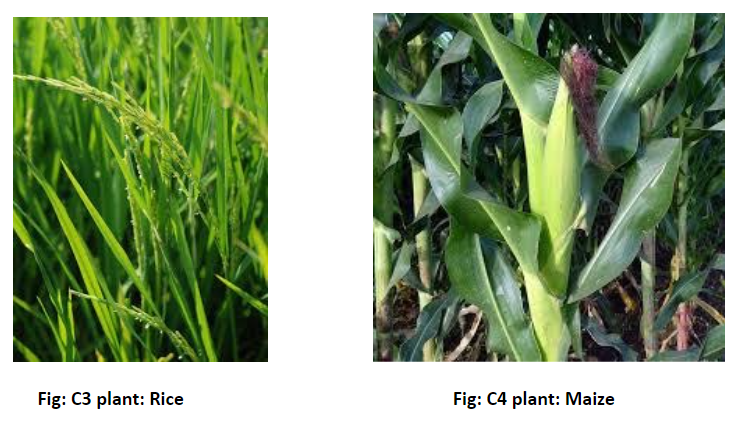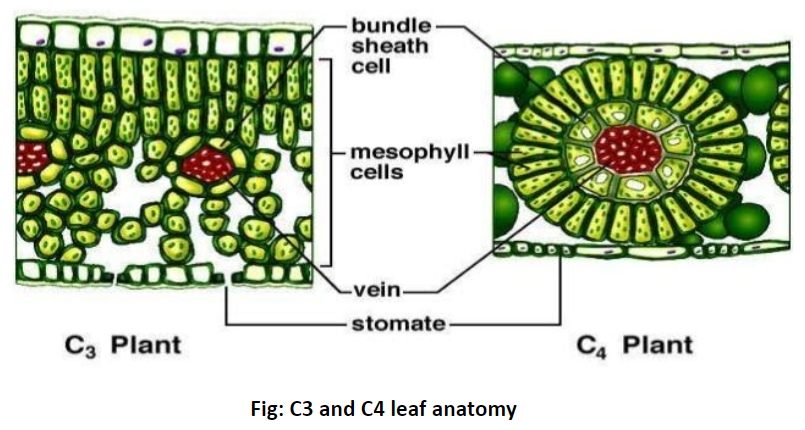
Answer
469.5k+ views
Hint: Transpiration is a very common phenomenon of water transport and photosynthesis is seen in all green plants. Crassulacean metabolism is seen in special types of plants that are usually seen in hot climate regions or places with high temperatures. Now, try to analyze where C3 and C4 plants are seen.
Complete answer: 1. In C3 plants, $O_2$ is driven directly into the Calvin cycle and leaves RuBisCO (Ribulose bisphosphate carboxylase/oxygenase) exposed to $O_2$.
2. RuBisCO then takes up $O_2$ and reacts with ribulose bisphosphate (RuBP) to produce 2-phosphoglycolate and 3-phosphogyceric acid. This whole reaction takes place in the chloroplast. The product 2-phosphoglycolate is a very toxic product and is of no use of plants. So, it undergoes certain chemical reactions to produce 3-phosphoglyceric acid.
3. The next set of reactions takes place in peroxisome and mitochondria where 2-phosphoglycolate converts to glycine and glycine convert to serine respectively.
4. The serine then comes to the peroxisome and converts to glycerate and this glycerate enters to chloroplast and produces 3-phosphogyceric acid.
5. Photorespiration occurs when concentrations of $CO_2$ is low and concentrations of $O_2$ is high.

6. C4 plants capture $CO_2$ is primarily captured by phosphoenolpyruvate or PEP in mesophyll cells to form oxaloacetate. This oxaloacetate is then converted to malate and transported to the bundle sheath cells, where oxygen concentration is low and releases $CO_2$, which is then taken up in the Calvin cycle. This mechanism is adopted by C4 plants to avoid photorespiration.
7. Photosynthesis is seen in all the green plants that have chlorophyll.
8. Transpiration is also seen in all plants to transport water that is absorbed from the soil by the root to the other parts of plants.
Crassulacean metabolism or CAM is only seen in Crassulaceae family plants, such as cactus.
So, the correct answer is option B. photorespiration.

Note: Transpiration takes place by xylem cells. Photorespiration takes place in chloroplast, peroxisome, and mitochondria. CAM pathway takes place in mesophyll cells during day and night. In C4 plants the $CO_2$ trapping and metabolism take place in both mesophyll cells and bundle sheath.
Complete answer: 1. In C3 plants, $O_2$ is driven directly into the Calvin cycle and leaves RuBisCO (Ribulose bisphosphate carboxylase/oxygenase) exposed to $O_2$.
2. RuBisCO then takes up $O_2$ and reacts with ribulose bisphosphate (RuBP) to produce 2-phosphoglycolate and 3-phosphogyceric acid. This whole reaction takes place in the chloroplast. The product 2-phosphoglycolate is a very toxic product and is of no use of plants. So, it undergoes certain chemical reactions to produce 3-phosphoglyceric acid.
3. The next set of reactions takes place in peroxisome and mitochondria where 2-phosphoglycolate converts to glycine and glycine convert to serine respectively.
4. The serine then comes to the peroxisome and converts to glycerate and this glycerate enters to chloroplast and produces 3-phosphogyceric acid.
5. Photorespiration occurs when concentrations of $CO_2$ is low and concentrations of $O_2$ is high.

6. C4 plants capture $CO_2$ is primarily captured by phosphoenolpyruvate or PEP in mesophyll cells to form oxaloacetate. This oxaloacetate is then converted to malate and transported to the bundle sheath cells, where oxygen concentration is low and releases $CO_2$, which is then taken up in the Calvin cycle. This mechanism is adopted by C4 plants to avoid photorespiration.
7. Photosynthesis is seen in all the green plants that have chlorophyll.
8. Transpiration is also seen in all plants to transport water that is absorbed from the soil by the root to the other parts of plants.
Crassulacean metabolism or CAM is only seen in Crassulaceae family plants, such as cactus.
So, the correct answer is option B. photorespiration.

Note: Transpiration takes place by xylem cells. Photorespiration takes place in chloroplast, peroxisome, and mitochondria. CAM pathway takes place in mesophyll cells during day and night. In C4 plants the $CO_2$ trapping and metabolism take place in both mesophyll cells and bundle sheath.
Recently Updated Pages
Fill in the blanks with suitable prepositions Break class 10 english CBSE

Fill in the blanks with suitable articles Tribune is class 10 english CBSE

Rearrange the following words and phrases to form a class 10 english CBSE

Select the opposite of the given word Permit aGive class 10 english CBSE

Fill in the blank with the most appropriate option class 10 english CBSE

Some places have oneline notices Which option is a class 10 english CBSE

Trending doubts
Fill the blanks with the suitable prepositions 1 The class 9 english CBSE

How do you graph the function fx 4x class 9 maths CBSE

Which are the Top 10 Largest Countries of the World?

What is the definite integral of zero a constant b class 12 maths CBSE

The Equation xxx + 2 is Satisfied when x is Equal to Class 10 Maths

Differentiate between homogeneous and heterogeneous class 12 chemistry CBSE

Define the term system surroundings open system closed class 11 chemistry CBSE

Full Form of IASDMIPSIFSIRSPOLICE class 7 social science CBSE

Change the following sentences into negative and interrogative class 10 english CBSE




